
The Army is gauging potential industry offerings for a new fire control sensor that would link up with the active protection systems (APS) the service is currently working to integrate across its vehicle fleet. A new Request For Information released April 12 details plans to find a vehicle-based fire control sensor for APS platforms capable of tracking threats, including anti-tank guided missiles, kinetic energy weapons and rocket-propelled grenades, between ranges of 50 meters and two kilometers. “This will enable the…

 By
By 











